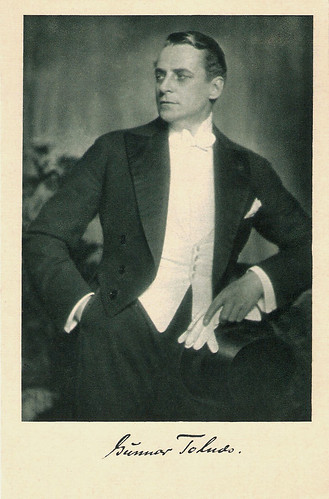
German postcard by Verlag W.J. Mörlins, Berlin / Vertrieb Ross-Verlag, Berlin, no. 9001/3. Photo: Karl Schenker.

Vintage postcard by ABC, no. 375/1.
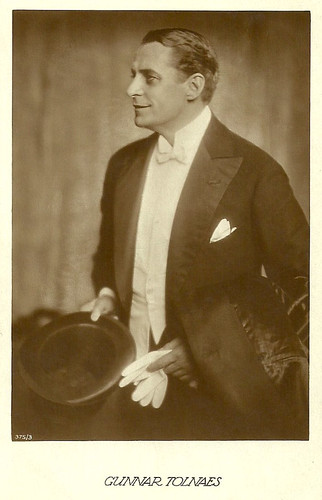
Vintage postcard by ABC, no. 375/3.
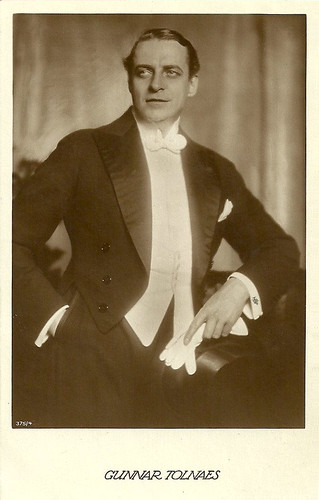
Vintage postcard by ABC, no. 375/4.

German postcard in the Film Sterne series by Rotophot. Photo: Nordisk. Collection: Didier Hanson.
Super Power
Gunnar Tolnaes (Tolnæs) was born in Christiana (now Oslo), Norway, in 1879. His parents were Ole Gundersen Tolnæs and Helene Andresen (Braathu).
Tolnaes studied law and later medicine. He made his stage début in 1906 and was a company member of the Nationaltheatret in Oslo between 1908 and 1916.
In 1913, he started his film career for the Swedish company Svenska Biografteatern AB in Stockholm and worked there with legendary director Victor Sjöström. They made the silent dramas Halvblod/Half Breed (Victor Sjöström, 1915) with Karin Molander, Gatans barn/Children of the Streets (Victor Sjöström, 1914) starring Lili Beck, and En av de många/One of the Many (Victor Sjöström, 1915).
He also worked with the other great director of the silent Swedish cinema, Mauritz Stiller. They made Bröderna/Brothers (Mauritz Stiller, 1914) with Carlo Wieth, and När konstnärer älska/When Artists Love (1915, Mauritz Stiller), with Lili Beck.
Then Tolnaes moved to Denmark, where he was offered a contract at the Nordisk studio. He was immediately successful with Doktor X/Doctor X (1915) directed by Robert Dinesen.
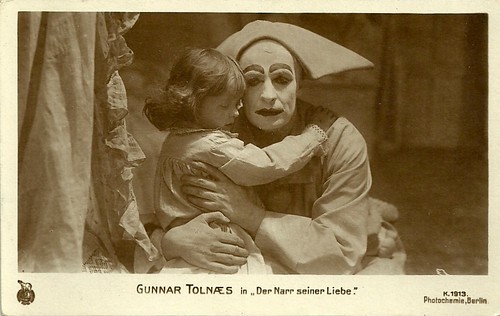
German postcard by Photochemie, no. K. 1913. Photo: Nordisk Films. Gunnar Tolnaes in Pjerrot (Hjalmar Davidsen, 1917), with Ulla Nielsen as The Child.
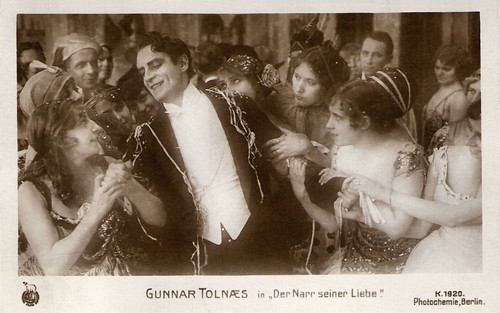
German postcard by Photochemie, Berlin, no. K. 1920. Photo: Nordisk. Publicity still for Pjerrot (Hjalmar Davidsen, 1917).
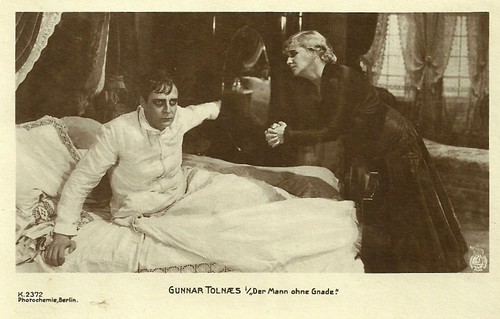
German postcard by Photochemie, no. K. 2372. Photo: Nordisk Films. Gunnar Tolnaes in Den Retfærdiges Hustru (A.W. Sandberg, 1917), co-starring Else Frölich.
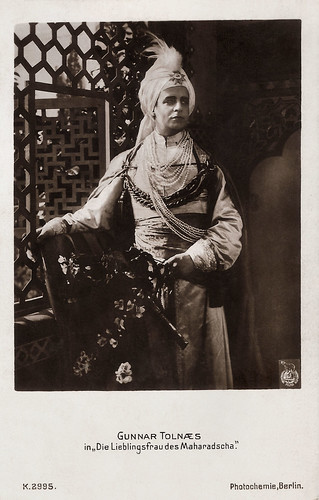
German postcard by Photochemie, Berlin, no. K. 2995. Photo: Nordisk. Publicity still for Maharadjahens Yndlingshustru/The Maharajah's Favourite Wife (1917).

German postcard by Photochemie, Berlin, no. K. 1976. Photo: Nordisk. Publicity still for Maharadjahens Yndlingshustru/The Maharajah's Favourite Wife (1917) with Lilly Jacobson.
Indian Prince
The studio heads at Nordisk hoped that Gunnar Tolnaes would become as popular as their biggest star, Valdemar Psilander.
Tolnaes had his most famous performance for Nordisk in the Orientalist melodrama Maharadjahens Yndlingshustru I/The Maharajah's Favourite Wife I (Robert Dinesen, 1917). He starred as an Indian prince and Lilly Jacobson was his love interest.
The film was so popular that it had a sequel in 1919, directed by August Blom and again starring Tolnaes and Jacobson. In 1921 the German studio PAGU would produce another sequel Die Lieblingsfrau des Maharadschas - 3. Teil/The Maharajah's Favourite Wife III (Max Mack, 1921) in which Aud Egede Nissen replaced Jacobson.
The Danish film industry was an international superpower in the 1910s and the Nordisk productions were the most successful of them all - especially in Germany. Among Tolnaes' successes were Den retfærdiges hustru/The Righteous Wife (A.W. Sandberg, 1917) with Else Frölich, Den mystiske tjener/The mysterious servant (A.W. Sandberg, 1917) and the Science-Fiction film Himmelskibet/400 Million Miles from Earth (Holger Madsen, 1918).
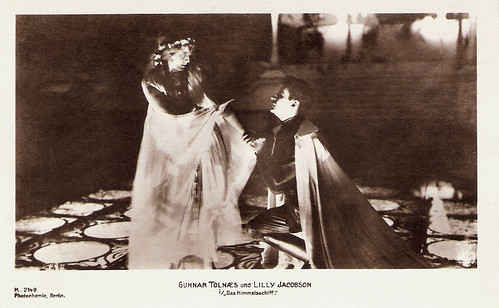
German postcard by Photochemie, Berlin, no. K. 2149. Photo: Nordisk. Publicity still for Himmelskibet/Das Himmelschiff (Holger-Madsen, 1918) with Lilly Jacobson as Marya, the Martian leader's daughter, and Gunnar Tolnaes as Avanti Planetaros.
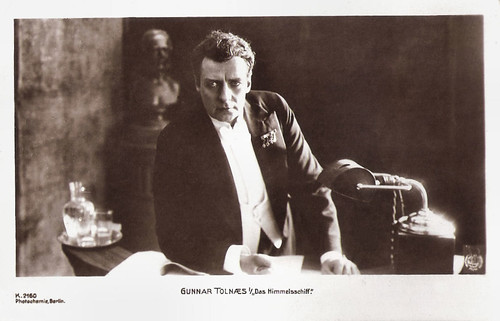
German postcard by Photochemie, Berlin, no. K. 2160. Photo: Nordisk. Publicity still for Himmelskibet/Das Himmelschiff (Holger-Madsen, 1918) with Gunnar Tolnaes as Avanti Planetaros.
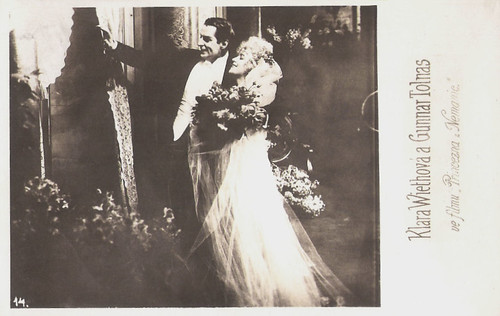
Latvian postcard, no. 14. Photo: Nordisk. Publicity still for Stodderprinsessen/The Rags Princess (A.W. Sandberg, 1920) with Clara Wieth.
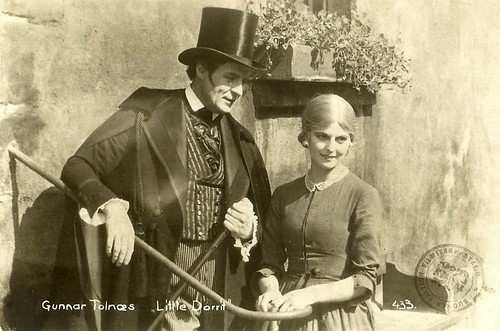
Finnish postcard, no. 433. The postcard carries a stamp of the Finnish film inspection office. Photo: publicity still for the Charles Dickens adaptation Lille Dorritt/Little Dorrit (A.W. Sandberg, 1924), starring Karina Bell as Little Dorrit and Gunnar Tolnaes as Arthur Clennam.
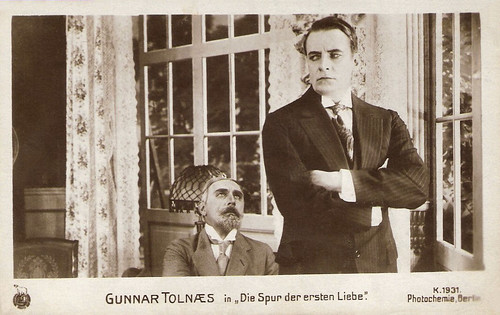
German postcard by Photochemie, Berlin, no. K 1931. Photo: Nordisk. Publicity still for Kærlighedsøen/Love Lake (A.W. Sandberg, 1924).
Less Success
In the 1920s, Gunnar Tolnaes worked often with famous Danish director A.W. Sandberg.
He appeared among others in his Stodderprinsessen/The Rags Princess (A.W. Sandberg, 1920) with Clara Pontoppidan aka Clara Wieth, Kan disse ojne lyve?/Can these eyes lie? (A.W. Sandberg, 1921), Min ven privatdetektiven/My Friend the Private Detective (A.W. Sandberg, 1924), and the Charles Dickens adaptation Lille Dorrit/Little Dorrit (A.W. Sandberg, 1924) with Karina Bell.
The Danish film industry gradually lost its supremacy in Europe, and Gunnar Tolnaes' films also had less success. He alternated acting in Danish films with roles in German films and continued to do so until the end of the silent era.
His first German film had been Die Lieblingsfrau des Maharadschas - 3. Teil/The Maharajah's Favourite Wife III (Max Mack, 1921). After this success he appeared in productions like Sturmflut des Lebens/Storm Surge of Life (Paul L. Stein, 1921) with Charlotte Ander, Die Flucht in die Ehe/The Flight Into Marriage (Artur Retzbach, 1922), and Wilhelm (later: William) Dieterle's Geschlecht in Fesseln/Sex in Chains (1928).
His last film was Der Narr seiner Liebe/Fool For Love (1929), directed by actress Olga Tschechova. Gunnar Tolnaes would never make a sound film. He died in 1940 in Oslo, aged 60. He is buried with his family at Vestre gravlund.

German postcard by Photochemie, Berlin, no. K. 1474. Photo: Nordisk.

German postcard by Photochemie, Berlin, no. K 1567. Photo: Nordisk.
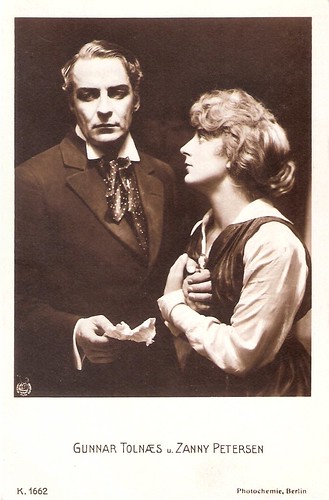
German postcard by Photochemie, Berlin, no. K. 1662. Photo: Nordisk. With Zanny Petersen. Publicity still for Pjerrot/Pierrot (Hjalmar Davidsen, 1917).
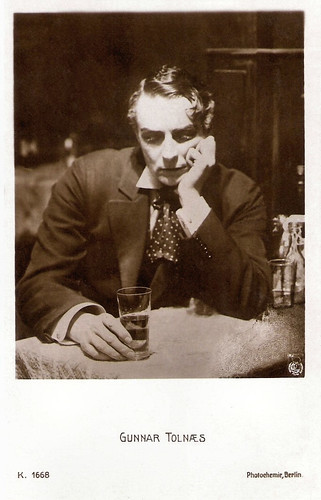
German postcard by Photochemie, Berlin, no. K 1668. Photo: Nordisk. Publicity still for Pjerrot/Pierrot (Hjalmar Davidsen, 1917).

German postcard by Ross Verlag, no. 1277/1, 1927-1928. Photo: Deutsch-Nordische Film Union. Publicity still for Maharadjahens yndlingshustru III/The Maharaja's Favourite Wife (A.W. Sandberg, 1926).

German postcard in the Moderne Künstler series by MMB, no. 453. Photo: F.J. Wesselsky.
Sources: Thomas Staedeli (Cyranos), Wikipedia (English, Danish and German) and IMDb.
This post was last updated on 25 September 2021.
No comments:
Post a Comment